Lecture and Performance Review: A Cultural Dialogue Beyond Translation
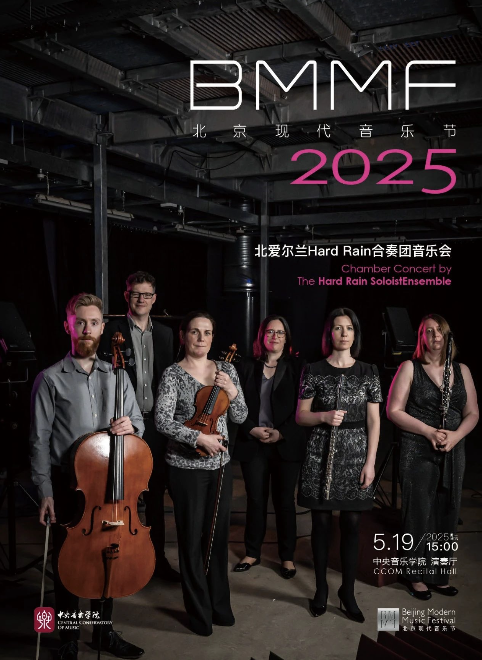
On May 19th, the Northern Irish Hard Rain SoloistEnsemble, visiting China for the first time, took the stage at the Beijing Modern Music Festival, delivering a feast of knowledge through a lecture and a concert.
At 10:00 AM, Irish composer Greg Caffrey, the founding artistic director of the ensemble, along with the group, presented a splendid audiovisual feast at the recital hall of the China Conservatory of Music's piano building. This composition lecture, themed "Between Orthodoxy and Innovation: Exploring the Composer's Creative Perspective," ingeniously wove together live performance and musical examples. It vividly showcased Caffrey's profound interpretation of a composer's creative intent, analyzing the personal experiences and background factors underlying the uniqueness of a composer's perspective.

The lecture began with Caffrey introducing composer Steve Reich. While listening to Reich's work, Caffrey subtly introduced a profound viewpoint: a composer's creative intent is not always readily apparent on the score; it often lies hidden within the composer's personal experiences and background.
Subsequently, Caffrey introduced his representative work, "Sunset Glow and Gathering Clouds," emphasizing the relationship between the score's information and the creative intent. Before formally analyzing the score, he innovatively invited the Hard Rain SoloistEnsemble to perform the opening passage of the work live. Instantly, nimble piano notes leaped forth, intertwining with the timbres of strings and woodwinds, creating an ethereal and beautiful soundscape. The exquisite use of string harmonics, in particular, painted a misty, picturesque, and dreamlike scene for the audience.
During the score analysis, Caffrey lucidly analyzed two distinctive elements of compositional technique in the musical fragment. The first was the clever use of the "octatonic scale," which he employed to create a dreamlike, "floating" sensation where reality and illusion intermingled. The second was the crescendo in the string section, which he stated was key to injecting surging tension into the work, allowing the overall music to release a powerfully moving force through its gradual intensification.
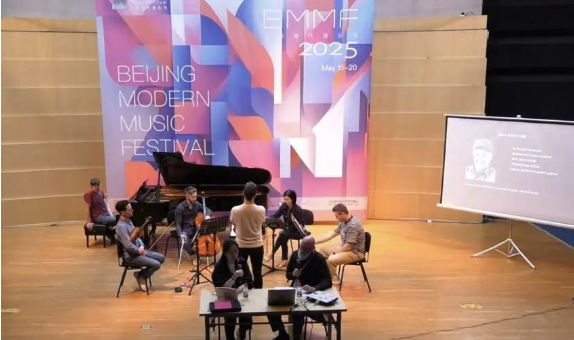
A composer's creative intent is also often reflected in the ingenious details of their work. As Caffrey explained, the two aforementioned characteristic elements were not only present in the opening passage but were core elements he used throughout the entire piece to showcase his individuality. In his view, the technical aspects of creation are often influenced by one's humanistic background, and the reasons why a composer chooses specific creative techniques are often the most interesting part of the entire creative process. These unique creative perspectives are, in fact, vivid reflections of the composer's life experiences, delicately and profoundly embodying their unique understanding of life.
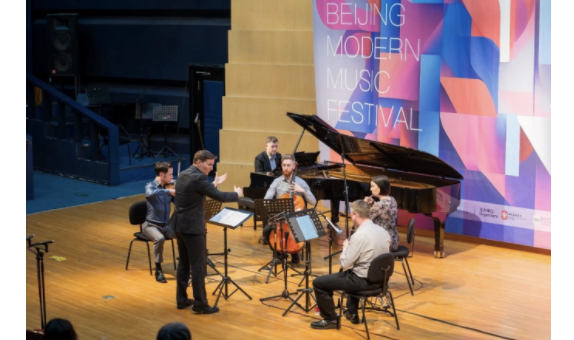
Every great artist interprets works through their unique perspective. Caffrey skillfully cited musical giants such as Bach, Messiaen, and Mahler, who poured their souls into their respective masterpieces, integrating their artistic worlds into their creations, making their works vehicles for self-expression and spiritual exploration. Caffrey used this to introduce his own orthodox and unorthodox experiences on his musical path, profoundly concluding that presenting music through a score is the technical foundation of composition; his experience learning jazz provided him with the possibility of broadening his use of harmony; and his unorthodox learning experiences offered endless space for thought and sources of inspiration during the creative process.
Thus, analyzing from a cultural perspective, "Sunset Glow and Gathering Clouds" was inspired by the poetry of Irish poet W.B. Yeats. As an elegiac work that incorporates the artistic conception of Yeats's poetry, the music expresses a purer emotion of loss, showcasing Caffrey's personalized interpretation and emotional projection of the poem. The work was composed in 2013 for the debut performance of the Hard Rain SoloistEnsemble. As the composer's brother had unfortunately passed away in January of the same year, the sense of loss expressed in this piece also became Caffrey's profound remembrance and sincere tribute to his brother.
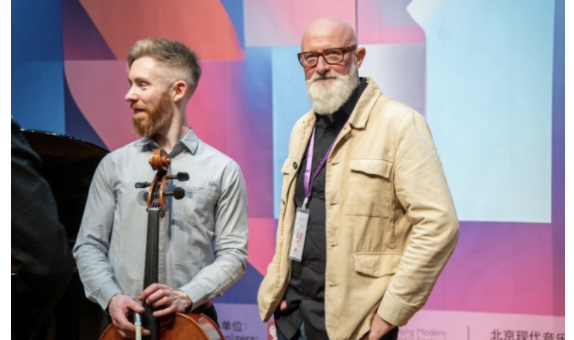
Towards the end of the lecture, Caffrey, with his work "Aingeal" (Irish for "Angel"), brilliantly showcased his extraordinary ingenuity in the use of percussion and string orchestra. In the subsequent Q&A session, the audience was highly enthusiastic, actively asking questions about topics such as the composer's creative intent, composition, and audience understanding. The atmosphere was lively and friendly, fully demonstrating the positive interactive state of the lecture.
This lecture was not only a feast of knowledge but also an exploratory journey born from the collision of technical rationality and artistic soul. Greg Caffrey, with his unique creative perspective, brought the audience a feast of music and thought, demonstrating how composers explore the space between orthodoxy and innovation, and how they integrate personal experiences and emotions into their musical creations. This lecture not only allowed the audience to appreciate the rich connotations and infinite charm of music but also stimulated everyone's reflection on the composer's intent behind musical creation, providing a valuable opportunity for learning and exchange.
Following the lecture, the ensemble made its much-anticipated appearance. At 3:00 PM that day, amidst the fervent applause and cheers of the audience, Northern Ireland's Hard Rain SoloistEnsemble performed eight modern works by eight Chinese and Irish composers in the recital hall of the Central Conservatory of Music.
From the deconstruction and reconstruction of Chinese musical charm by Western instruments to the mysterious romanticism of Ireland in Yeats's poetry flowing through the notes; from sketching the youthful heroism of Huo Qubing, an Eastern legend, with musical brushstrokes, to the epic quality of Norse mythology reverberating in melodies; from a philosophical gaze on the "fundamental state zero" of life's true state, to the resonant aesthetics generated by music and spatial fields... This concert transcended geographical and cultural boundaries. It was not only an in-depth dialogue between China and Ireland in modern music but also a spiritual resonance of Eastern and Western cultures across time and space. In the interweaving and collision of notes, it outlined a common human emotional landscape and aesthetic pursuits.
The concert opened with Caffrey's "Sunset Glow and Gathering Clouds." The piece was born from Caffrey's profound response to Yeats's poem "Easter, 1916" (often associated with the line "A terrible beauty is born"). Academics often interpret Yeats's original poem as a requiem for the decline of traditional Irish spirit under the impact of modernity, but Caffrey chose to strip away historical metaphors, focusing on the universal emotion of "loss" through pure musical language.
The interweaving of strings and woodwinds was like a hazy mist in the twilight. The composer's exploration of "ethereal aesthetics" at that time was fully evident here: the exquisite arrangement of the harmonic series simulated the imagery in the poem – "Hearts with one purpose alone / Through summer and winter seem / Enchanted to a stone" (or as interpreted in the text: "the heart seeks only one thing, to become stone amidst life and labor") – making the sound an emotional container suspended outside of time, leading the audience into a realm of poignant sorrow that transcended geographical boundaries.
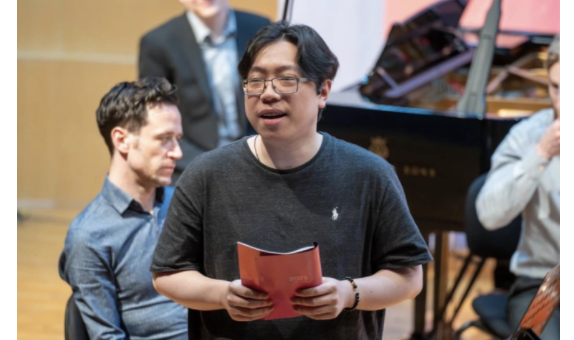
It is worth mentioning that the composer of this piece, Caffrey, founder of the Hard Rain SoloistEnsemble, was present to unveil this "sound poem" layer by layer, setting a pure and emotional tone for the entire concert.
Zhang Shuhao's "Three Hidden Phenomena" used the life rhythm of a flower as its timeline, constructing a sound-state space of "budding," "secluded blooming," and "ephemeral passing" through three interconnected movements. The frequent use of flute air techniques in the performance enriched the music's expressive layers and auditory effects, adding further impetus to the already lively and leaping rhythm, like sap surging secretly within the flower stem, finally pushing the flower to bloom.
In the second part, the flute section used circular breathing to construct a three-dimensional sound field of petals unfurling one by one, while the piano's displaced accents, like falling dewdrops, shattered the linear narrative of time. Finally, the piece transitioned to a harmonic base of a twelve-tone row, with the flute's fragmented motifs and the piano's sustained pedal notes interweaving to create a trajectory of "blooming is fading"—sound completing its philosophical inquiry into the essence of life through continuous collapse. The work reconstructed the sound-state space of plant growth from a microscopic perspective, fusing technical experiments such as microtonal intervals, air-sound techniques, and spectral control with poetic metaphors into an auditory ritual about existence and annihilation.
The third piece was Ni Chenkang's "Firecracker Dragon Dance." The Firecracker Dragon Festival is a comprehensive folk festival in the Binyang County area, representing a fusion of Han and Zhuang cultures. "Dancing the Firecracker Dragon" involves burning firecrackers to "bombard" the wildly dancing dragon. It is believed that the more firecrackers are burned, the longer the dragon stays in front of one's home, bringing more luck. The festival is also believed to embody prayers for favorable weather and good fortune. The most outstanding aspect of the performance was the depiction of the bustling and noisy festival scene; the composer used music to render the thundering sound of firecrackers and the sight of dragons tumbling and dancing in the green smoke.
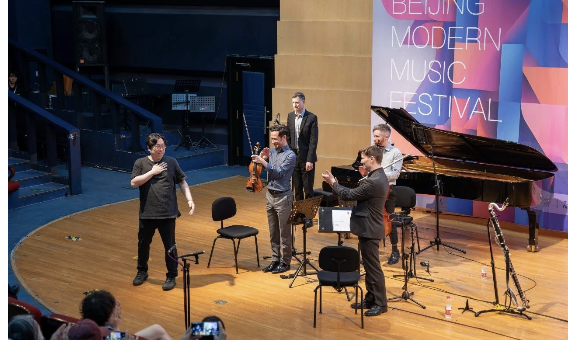
In an interview after the concert, cellist David mentioned that this was one of the pieces that interested him the most in the entire concert. He was amazed that Chinese dragon culture could be presented in such a stunning form in a modern musical work and marveled at how the composer used and combined complex cello techniques such as aggressive scratch tones and intense pizzicato, developing the cello's timbre to its fullest. This was a spontaneous spiritual collision between composer and performer, aiming to showcase the wildness and tension of Chinese dragon culture, achieving a leap for this intangible cultural heritage from folk ritual to contemporary art amidst an acoustic explosion.
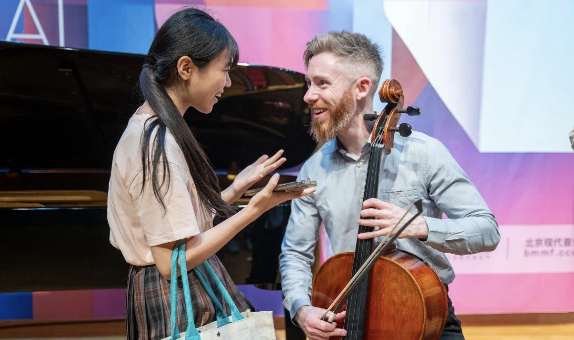
The first half of the concert concluded with a piece from the misty realm of Northern Irish mythology—Anita Mawhinney's "Macha's Echo." The work's inspiration comes from the Celtic myth of Macha, the Ulster goddess of war. The core texture of the piece focuses on a chorale derived from a primitive choral fragment. As the mixed texture unfolds in fugal form, Macha's secret vow to her husband Crunniuc is revealed layer by layer within the polyphonic structure: "Do not speak of me to the world, for no one knows Macha can ride the wind." This whisper from the mythical text, through the special treatment of microtonal intervals in the strings and the deep modulation of high and low voices in the sound field, transforms into a sound ghost weaving among the instruments, alluding to the goddess's "ineffable" divine nature and, through the logic of musical recurrence, metaphorically representing the eternal echo of the legend in collective memory.
The second half began with Ryan Molloy's "Gortnagarn II," a personalized meditation on the connection between people, place, and landscape, profoundly exploring the unique experience of belonging to a specific piece of land. The piece opened with a highly aggressive long-tone texture, with the sustained flute timbre repeatedly hovering in a frequency range that resonates with the human auditory comfort zone. This constant pitch and timbre were not only a physical sound presence but also constituted an auditory "geographical coordinate"—when the overtones of the wind instruments vibrated sympathetically with the audience's brainwaves, the work's core image of "the connection between humans and the land" was deeply implanted in the audience's subconscious. In the middle section, the flute gradually moved away from this sound, beginning to perform a more soaring melody with continuous ascending lines. The bass clarinet took over the frequency foundation from the alto flute, continually deepening the sonic roots in the low-frequency range, while the ascending melody in the high-frequency flute built an auditory spiritual altitude on another level. This was not only an acoustic experiment deeply connecting with the audience but also an auditory philosophical ritual about existence and space.
Wang Amao's "Playing Bamboo, Plucking Silk" appeared as the second piece in the second half. This work was originally commissioned by the Juilliard School's 2018 Focus Festival for an ensemble of Western woodwind instruments and piano. The piece cleverly transfers the unique expressive techniques of Chinese dizi and xiao, such as airy vibrato, trills, and flutter-tonguing, to Western instruments. Between the black and white keys of the keyboard and the tone holes of the woodwinds, it melds the charm of Chinese qin and xiao art and the spirit of the literati into the sound system of Western instruments. The Eastern charm it showcased within Western music immediately became an exemplar of cross-cultural creation at this concert.

The ancient simplicity of the qin and the remoteness of the xiao have long been tangible expressions of the Eastern musical spirit. However, innovative attempts to integrate them with Western instruments also reflect the fundamental differences between Chinese and Western instruments. In the performance, the musicians vividly demonstrated unique Chinese musical techniques such as airy vibrato, trills, and flutter-tonguing from the Chinese dizi and xiao. However, from the perspective of the instruments' sound-producing materials and principles, the metal tube of the flute and the bamboo cavity of the dizi/xiao have natural differences in resonant structure, making it difficult for the timbre in the high register to achieve the warm and mellow quality of Eastern instruments. This is much like the collision of Eastern and Western cultures, where there are both stunning breakthroughs of innovation and regrettable instances of incompatibility. This contradiction and tension, paradoxically, make the work a unique sample for observing cross-cultural music creation, a rare attempt in modern music to seek resonance amidst differences.
Song Yue's "Iron Horse" was the climax of the concert's second half. This piece portrays the legendary deeds of Huo Qubing, a famous general of the Western Han Dynasty. This military genius of Emperor Wu's era heavily defeated the Xiongnu confederation at the age of 18. In 121 BC, he twice led his troops into the Hexi Corridor, crushing the Xiongnu kings Xiutu and Hunye, securing strategic locations for the Han Dynasty, and opening up the northern route of the Silk Road. Ban Gu recorded in the "Book of Han": "The Champion General, swift and brave, surged forth. Six long campaigns, striking like lightning and thunder. Watering horses at the Han Hai, enfeoffing Mount Langjuxu. Westward he planned for the Great River, establishing commanderies by the Qilian Mountains."
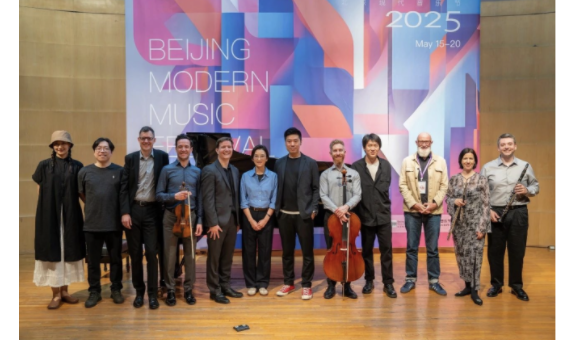
This piece extols the general's heroic posture and laments his untimely death, sketching a historical scroll with exquisite musical language. The music immediately presents elements of nomadic long-song folk melodies, bringing the vastness of the grasslands to the listener's ears. The violin's continuous tremolo was like the whistling wind and sand of the Hexi Corridor, while frequent high glissandi represented both the neighing of warhorses and the metallic clang of clashing weapons. The cello's firm spiccato was like Huo Qubing's determined, powerful, and advancing horse hooves.
Suddenly, the flute abruptly switched to the sharp sound of the piccolo, its urgent timbre like flying war reports. At a critical moment, the cello became even more steadfast, like Huo Qubing's fearless and rock-solid determination. The piece concluded, seemingly echoing the ancient saying, "Beauties and famous generals since ancient times are not allowed by heaven to see old age." Huo Qubing died young at 23. Amidst the violin's drone (or "humming sound"), the wind and sand gradually subsided, and the battlefield returned to desolation. Although the young general was long gone, his legend of world-conquering spirit still reverberated across the vast grasslands.
Finally, the concert concluded with Jeff Hannan's "Breaking News," which used satirical and sharp musical language to construct a profound critique of the cyclical reporting mechanism of television news. As Neil Postman pointedly noted in "Amusing Ourselves to Death," the nature of the television medium makes it incapable of carrying serious topics, just as smoke signals cannot convey philosophical speculation. When television forcibly tries to be serious, it instead exposes a deeper absurdity.
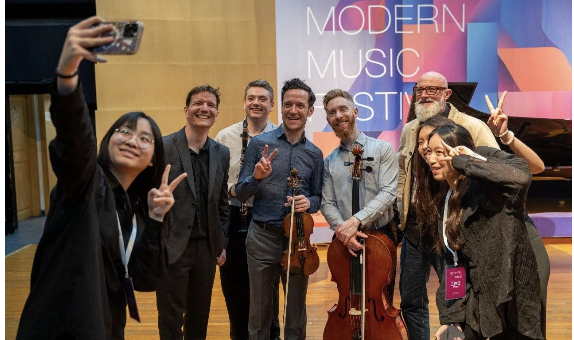
This was the composer's musical reflection on the contemporary media ecology. Those fragmented musical passages, sometimes creating a sense of absurdity with comical decomposed harmonies, sometimes simulating the serious posture of a news broadcast with deliberately solemn chordal harmonies, mirrored the intrusive feeling of "breaking news" coming at us from all directions in our lives. As the piece progressed, the increasingly dense interweaving of various parts was like the proliferation of news fragments in the tide of informatization. Various inserted passages in the music arrived one after another—in the fast-paced information bombardment, the boundaries between true and false, important and trivial, were completely blurred, ultimately devolving into a never-ending auditory carnival. "Breaking News" used a musical prism to refract the bizarre and motley landscape of contemporary media ecology, completing a musical interpretation of Postman's critical theory.
As the last note gradually faded in the space of the Central Conservatory of Music's recital hall, applause thundered, a tribute not only to the musicians' skill but also an acclamation for the modern music exchange between the two countries. In interviews after the concert, both the flutist and the cellist mentioned the word "anticipation." This anticipation had arisen the moment they received the scores, and despite the extremely tight rehearsal schedule, the musicians of the Hard Rain SoloistEnsemble perfectly presented all the works.
When different civilizations are willing to approach each other with a listening posture, even if the instruments are different and cultures vary, those pure aesthetics and affections will ultimately, in the ripples of sound waves, weave a spiritual spectrum that illuminates the globe. This is perhaps the true meaning of modern music. The eight works, like eight prisms, in the overlap of modern music and Chinese-British cultures, reflected the eternal inquiries of musicians from two nations into existence, time, and space, solidifying this modern music dialogue across Eastern and Western civilizations into an amber of musical culture.
Executive Director | Guo Hai'ou
Executive Assistants | Zhang Shuhao, Yin Nan
Copywriters | Wang Yicong, Li Jiaxuan
Photographers | Zhang Yaxuan, Zhang Yibin
